It is almost impossible to confuse this brittlegill with any other member of
the Russula genus. Its habitat requirements - damp ground beneath birch -
and its pure yellow cap and flesh that greys slowly when cut are clear distinguishing features.
Distribution
Fairly common and widespread in damp woodland that contains birch trees, Russula claroflava occurs throughout Britain and Ireland and wherever there are birch trees in northern and central mainland Europe. This species is recorded also in North America, and in particular the Pacific Northwest.
Taxonomic history
The Yellow Swamp Brittlegill mushroom was described in 1888 by British mycologist William Bywater Grove (1838 - 1948), who gave it the binomial scientific name Russula claroflava which mycologists still use today when referring to this species. Born in Birmingham, England, Grove is perhaps most famous for his translation into English of the mycological treatise of Louis Rene and Charles Tulasne: Selecta Fungorum Carpologia (3 volumes, 1861-1865).
Synonyms of Russula claroflava include Russula constans Britzelm., Russula ochroleuca var. claroflava (Grove) Cooke, Russula flava Lindblad, and Russula decolorans var. constans (Britzelm.) P. Karst.
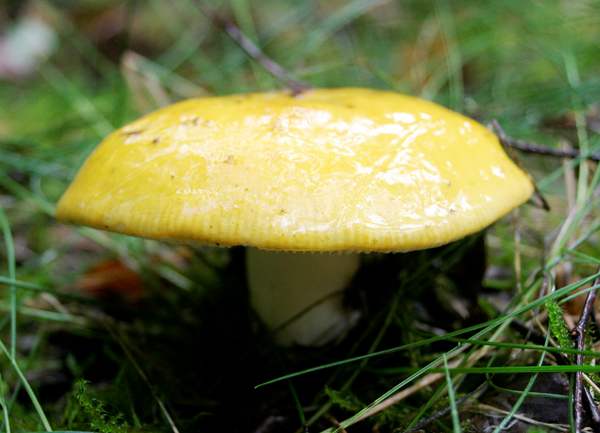
Etymology
Russula, the generic name, means red or reddish, and indeed many of the brittlegills have red caps (but many more are not, and several of those that are usually red can also occur in a range of other colours!). The specific epithet claroflava comes from clar- meaning brilliant or bright, and -flava meaning yellow. Bright yellow is a very good description of the caps of the Yellow Swamp Brittlegill.
Identification guide
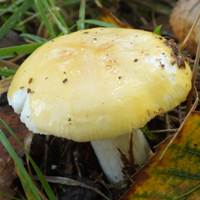 |
Cap
4 to 10cm in diameter, the caps are convex at
first, later flattening and often with slightly
depressed centres.
Bright yellow, sometimes fading to ochre-yellow, the cap surface is
smooth when dry and sticky when wet. The cuticle peels half-way to the
centre, and the flesh beneath the cuticle is white, greying slowly where
cut or broken. |
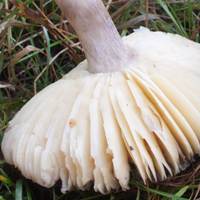 |
Gills
Adnexed or occasionally free, the fairly crowded, forked
gills are pale ochre; they darken gradually as the fruiting body ages.
Stem
10 to 20mm in diameter and 4 to 10cm tall, the brittle stems are white at first
but becoming greyer with age or when damaged. The stem flesh is also white, and there is no stem ring. |
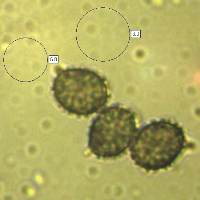 |
Spores
Ellipsoidal, 8-9.5 x 6.5-8μm (excluding spines); ornamented with blunt mainly-isolated warts up to 0.6μm tall with just a few connecting lines.
Spore print
Pale ochre-yellow. |
Odour/taste |
No significant odour; mild or slightly hot taste. |
Habitat & Ecological role |
In damp birch and Aspen woodland. In common with other members of the Russulaceae, Russula claroflava is an ectomycorrhizal mushroom. |
Season |
July to October in Britain and Ireland. |
Similar species |
Russula ochroleuca has
an ochre-yellow cap, often greening slightly in the middle; it has
fairly hot, peppery flesh. |
Culinary Notes
Don't be put off by the word 'swamp' in the common name, you don't have to risk life and limb to gather these mushrooms: Yellow Swamp Brittlegills occur in damp mossy woodland under birches where the soil is quite firm enough to walk on. Russula claroflava is an edible mushroom with a pleasant taste and
texture. Sautéed with onions and garlic these easy-to-spot fungi are quite highly regarded by people who enjoy eating wild mushrooms. These firm-textured mushrooms can be served with meat dishes; alternatively they make tasty omelette fillings or of course they can be used in mushroom soups or stews.
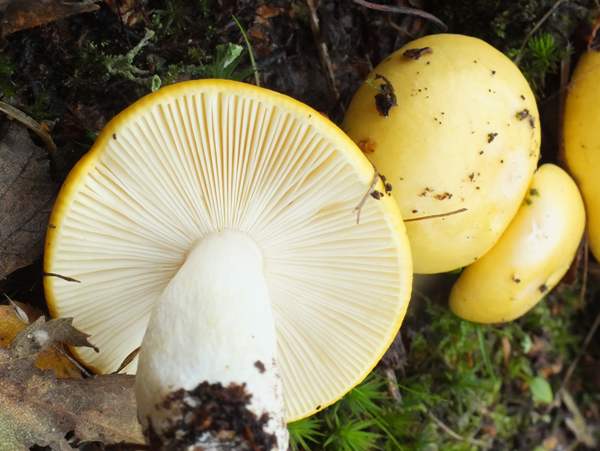
Reference Sources
Pat O'Reilly (2016). Fascinated by Fungi, First Nature Publishing
Geoffrey Kibby (2011).The Genus Russula in Great Britain, published by G Kibby.
Roberto Galli (1996). Le Russule. Edinatura, Milan.
Paul M. Kirk, Paul F. Cannon, David W. Minter and J. A. Stalpers. (2008). Dictionary of the Fungi; CABI.
Taxonomic history and synonym information on these pages is drawn from many sources but in particular from the British Mycological Society's GB Checklist of Fungi.
Top of page...
Fascinated by Fungi. Back by popular demand, Pat O'Reilly's best-selling 450-page hardback book is available now. The latest second edition was republished with a sparkling new cover design in September 2022 by Coch-y-Bonddu Books. Full details and copies are available from the publisher's online bookshop...